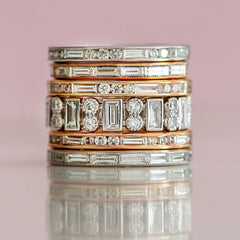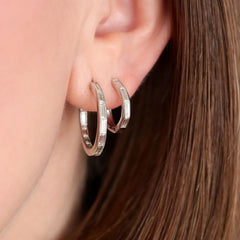

Baguette diamonds are a distinct and elegant diamond cut known for their clean lines, understated sparkle, and art deco appeal (as seen above in our Silhouette White Diamond Band, Modern Heritage White Diamond Band, and Petit Baguette White Diamond Ring). Read our comprehensive guide to learn what makes baguette diamonds unique, their history, and how they are used in jewelry.
What Is a Baguette Diamond?
- Cut: A baguette diamond is a step-cut diamond, meaning it has rows of parallel facets that resemble steps.
- Shape: Rectangular or, less commonly, tapered (one end narrower than the other).
- Facets: Typically 14 facets, which gives it a more subtle, glassy shimmer rather than a fiery sparkle. We love this look in our Rolo White Diamond Wide Band.


Why Is the Baguette Cut Unique?
- Minimalist Aesthetic: The clean lines and geometric shape evoke modernity and elegance, as seen in our Madison White Diamond Necklace and Zeena White Diamond Necklace.
- Less Sparkle, More Clarity: Fewer facets make inclusions and color more visible, so clarity and color are more important.
- Precision: Sharp corners and symmetry require expert cutting to avoid chips and ensure durability.
- Versatility: Suitable for both vintage and modern designs.


Why We Like Working with Baguette Diamonds
- Elegant Simplicity: Their subtle shine is perfect for those who prefer a refined look, as seen in our Silhouette White Diamond Hoops.
- Complementary Use: Often used as side or accent stones that enhance the center diamond.
- Art Deco Appeal: Popular in vintage and Art Deco-inspired jewelry for their architectural precision.
- Budget-Friendly: Typically less expensive than brilliant cuts due to simpler cutting and lower demand.


History of the Baguette Cut
- Origin: The name "baguette" is French for "stick" or "rod," reflecting the shape.
- Art Deco Era: Rose to popularity in the 1920s–30s during the geometric jewelry movement.
- Hollywood Glamour: Continued into mid-century and remains a classic choice today.
Uses in Jewelry
-
Accent Stones:
- Flank a larger center stone in engagement rings.
- Ideal for channel or bar settings due to their straight lines.
-
Eternity and Wedding Bands:
- Used in channel settings for a continuous, sleek sparkle.
-
Earrings and Bracelets:
- Common in tennis bracelets and drop earrings for minimalist elegance.
-
Necklaces:
- Layered in tennis necklaces for a fun and modern look.
-
Statement or Fashion Rings:
- Sometimes used as the main stone in modern or retro settings.
Variations and Similar Cuts
- Tapered Baguette: One end is narrower; used to wrap around curves or central stones.
- Straight Baguette: Uniform width; best for linear designs.
- Baguette vs. Emerald Cut: Emeralds are also step-cut but larger with more facets.
- Baguette vs. Princess/Baguette Mixes: Combined for contrast in halo settings or bands.
Care and Considerations
- Vulnerable Corners: Prone to chipping; protective settings like channels or bezels are best.
- Less Brilliance: Their appeal lies in refinement and geometry, not sparkle.
- Color and Clarity Matter: Fewer facets make flaws more visible, so choose higher grades.
